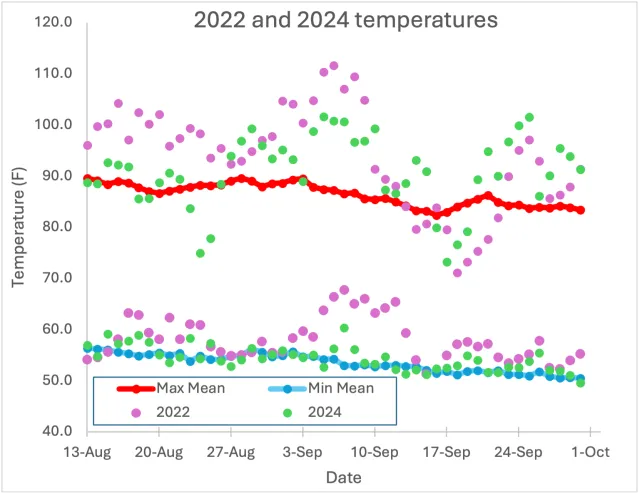Short answer: Not like we did in 2022. However, in the northern part of Sacramento Valley, temperatures are forecasted to be warm and chalkiness may be an issue for a sensitive variety like M-211. You can read on for more.
Grain chalkiness occurs when there are high temperatures (especially at night) during grain fill. Chalkiness impacts both grain appearance and lowers milling quality. Depending on planting dates and variety, grain filling can start in mid-August and run through September.
I gathered temperature data from the three main CIMIS stations in the rice region (Davis, Maxwell and Biggs); and I use the average of these three stations to provide a broad view of the valley temperature. In general, temperatures (especially nighttime temperatures) will be higher in the north than in the south.
2022 was the big problem year where the chalkiness problem was brought to our attention. While most prevalent in the variety M-211, it was noted in all varieties. In 2022, between Sept 1 and 9, high temperatures ranged from 101 to 112 oF and nighttime temperatures were in the upper sixties (Figure 1). All well above averages. In 2024, we also saw high daytime temperatures during a period early in September, but nighttime temperatures were relatively normal. In 2024, chalkiness was not a problem.

Figure 1. Long -term average maximum (Max-the top group of data) and minimum (Min-the bottom group of data) temperatures and Max and Min temperatures for 2022 and 2024. The time period from mid-August thorough September coincides with grain filling. Data are averages from three CIMIS stations in Sacramento Valley.
Over the next week we are going to experience warmer than normal temperatures and I have been asked if I think this may impact chalkiness. In looking at the weather forecast, and starting August 29 and running through September 5, temperatures are going to be warm. The temperature ranges for different locations around the valley during this period are shown in Table 1. Certainly, these temperatures are lower than what we saw in 2022 but they are slightly higher in 2024 (Figure 1). Based on this, I would not expect to see anything like we saw in 2022 in terms of chalkiness and grain quality. In the southern part of the valley, I see no problem at all. However, in the northern part of the valley, the nighttime temperatures are projected to be warm (up to 70), and for sensitive varieties like M-211, there may be some chalkiness. Unfortunately, from a management perspective, there is not much that one can do to alleviate this concern.
M-211 is very sensitive to having water drained too early. Draining early can have a large negative impact on M-211. Given the warmer weather and the sensitivity of M-211, it may be advisable to make sure not to drain the field too early on M-211 fields.
Table 1. Forecasted temperatures (Fahrenheit-F) from August 29-Septemeber 5. Data from Weather Underground (www.wunderground.com).
| Location | Range in high temps (F) | Range in low temps (F) |
| Sacramento | 97-103 | 61-65 |
| Willows | 101-108 | 62-70 |
| Biggs | 99-105 | 63-70 |
